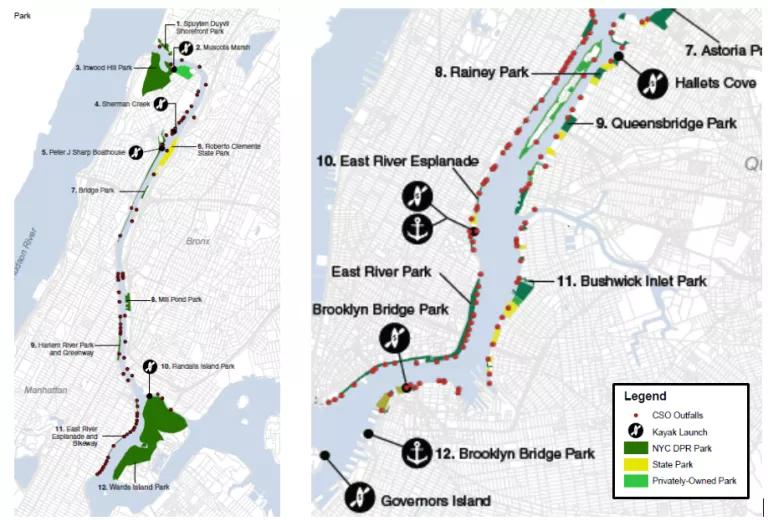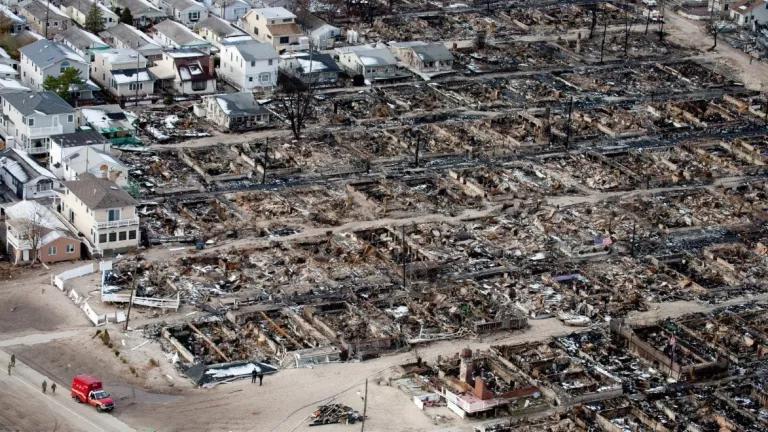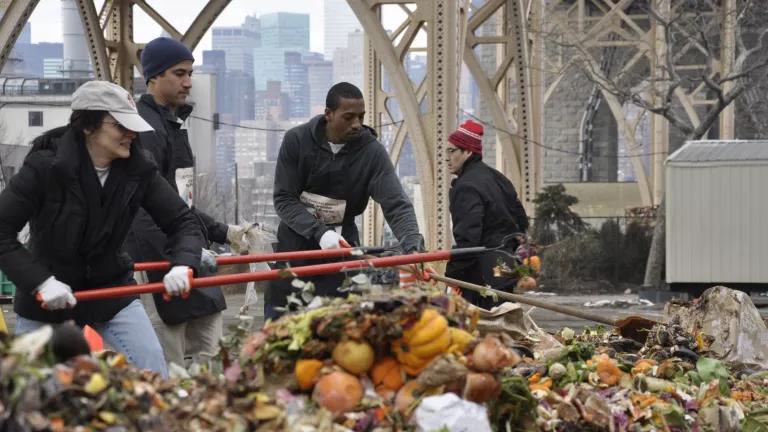NYC’s New Plan Would Let Massive Sewage Overflows Continue
Almost every time it rains in New York City, raw sewage, pet waste, trash, and polluted runoff flow into waterways where people swim, fish, row, kayak, and boat.
On any given day in 2019, there was nearly a 50 percent chance that sewage pollution made it unsafe to touch the water somewhere in New York City. In fact, every year, around 20 billion gallons of untreated raw sewage and polluted runoff bypass the city’s sewage treatment plants and get dumped into the water along the shoreline in all five boroughs.

Almost every time it rains in New York City, raw sewage, pet waste, trash, and polluted runoff flow into waterways where people swim, fish, row, kayak, and boat. As little as one tenth of an inch of rain can overwhelm the city’s sewers and sewage treatment plants.
Overflows occur regularly along the shorelines of waterfront parks and other public access points, like Hudson River Park, Inwood Hill Park, Roberto Clemente State Park, Astoria Park, Brooklyn Bridge Park, and Snug Harbor.

Map of sewage overflow locations ("CSO outfalls") and public access points along the Harlem River, which separates Manhattan and the Bronx. Maps of other areas can be viewed here.
Source: NYC DEP, “Combined Sewer Overflow Long Term Control Plan for Citywide/Open Waters, Recommended Plan Summary,” Jan. 29, 2020.
Not only is this gross but it’s also incredibly dangerous, putting those who come into contact with contaminated water at risk of developing intestinal illnesses, rashes, and infections.
The city's Department of Environmental Protection (DEP) is responsible for addressing this mess but keeps falling short on the task. A series of plans revealed over the last several years—each one for a different waterbody—is deeply flawed and would continue to allow massive amounts of sewage to flow into waters across the city, for decades to come. They also don't take full advantage of solutions like green infrastructure—including rain gardens, green roofs, and street trees—that improve our neighborhoods and keep our waters clean.
So far, the state has been approving these plans, over objections from community members and environmental watchdogs like NRDC.
Now, DEP has released a draft of its last remaining plan, which covers the city’s biggest waterbodies. These areas account for more than half of the city’s total sewage overflows by volume and about three-quarters of all overflow points along the shore.
Specifically, the plan covers the Hudson River, East River, Harlem River, and Long Island Sound. It also includes the open waters of New York Harbor from the tip of Manhattan to the ocean (Upper and Lower New York Bay), as well as Kill van Kull and Arthur Kill (which separate Staten Island from New Jersey).
The big reveal came at a public meeting on January 29. DEP reported that 11 billion gallons of raw sewage mixed with polluted runoff overflows into these waters annually. In what was supposed to be a plan to clean up this foul mess, DEP proposed leaving over 10.5 billion gallons behind—a reduction of only two percent compared to DEP's "baseline" conditions.
Only a handful of locations would see any improvement at all. These are mostly way off the beaten path.
Over 300 discharge locations would see zero reductions, continuing to overflow up to 80 or more times per year.
And the minuscule reductions DEP proposed wouldn’t be achieved until about the year 2030.
Incredibly, DEP says that’s good enough to make our waterways “clean”—under the federal Clean Water Act that promised “fishable, swimmable” waters by 1983.
How do they attempt to justify that? In large part, by hiding behind outdated New York State standards, which are based on discredited science, to define what counts as clean.
The U.S. Environmental Protection Agency (EPA) abandoned those standards decades ago. But that's the only target New York City is aiming to meet. If you ask the wrong questions, you’re bound to get the wrong answer.
The state’s standards turn the whole exercise into a statistical game, and they use the wrong playing pieces to boot. The standards average out the filthy days (when the water is filled with sewage) with the clean ones. And they literally look for the wrong thing in the water, failing to measure the bacteria that most clearly indicate a health risk.

Precisely for those reasons, EPA confirmed again in 2018 that the standards are “not scientifically defensible” for use in these waters.
NRDC and our partners are suing EPA to force it to upgrade the standards. The City asked the judge to throw out the case, as did EPA and the state of New York. With the case still pending, the state is also trying other legal maneuvers to let the city avoid more protective standards.
Amidst all of this legal wrangling, it’s not surprising that the City can’t quite keep its story straight. When it comes to issuing health advisories, as noted above, the city admits the water is unsafe half the time. Yet, when it comes to actually cleaning up the pollution, the water’s fine, they say. Move along. Nothing to see here. Check the box and move on.
So what would happen if the City were to ask—and answer—the right questions about sewage overflows? New Yorkers want to know:
- Where, when, and how severe are the impacts of sewage overflows to people who want to enjoy the greatest natural resources the city has to offer?
- What can we achieve in the next 5 years, 10 years, 20 years, if we really focused on reducing those impacts and cleaning up our waterways?
- How can we make sure that progress isn’t undermined by the increased precipitation we can expect climate change to bring to this region?
- And exactly what combination of solutions, including both green infrastructure and traditional infrastructure, can get us across the finish line to fishable, swimmable waters, over the long term?
Nothing in DEP’s proposed plan asks or answers those questions.
DEP invited comments on the proposal until March 2. [UPDATE: Don't hesitate to tell them what you think any time, even after this date. You can use the link below.]
By the end of March, DEP will then finalize its plan and submit it to the state for review. DEP says that this submission will include responses to public comments.
Then the state, which has enforcement authority over the city’s sewer system, needs to either approve the plan or disapprove it and insist on something better.
And, although EPA has been silent on the city’s prior sewage overflow plans, it has the authority to step in if the state falls short.
So, now is a critical time to weigh in before final decisions are made. Do you want a cleaner, healthier future, where the waters that course through New York City can be safely enjoyed by millions of New Yorkers? You can click here to send a message to city and state officials—including Mayor de Blasio and Governor Cuomo—to demand the real sewage cleanup plan that New Yorkers deserve.




